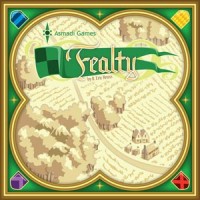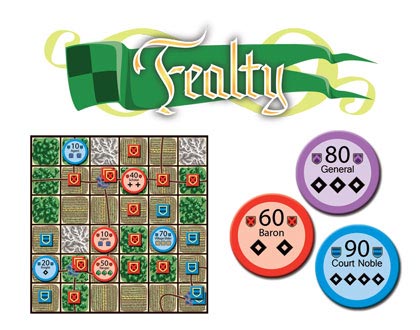
Fealty
The King is dead! And your eyes are set on the throne. To be victorious in the coming succession struggle, you must spread your influence across the countryside.
Every space you capture brings you one step closer to the crown! Your foes will field a set of pieces identical to yours, so you will need to outwit and outmaneuver them to succeed. Weighing the choice between capturing valuable cities or larger swaths of forests and fields will be a key concern.
Every play will vary, as there are twelve 6x6 duchies that will fit together to form the kingdom. In addition, the game includes two sets of units and cards for each color. Before playing, you choose one set to use.
One copy of Fealty contains enough pieces, boards, and cards to play two simultaneous two-player games or a single two, three, or four player game.

User Reviews (1)
Add a Review for "Fealty"
You must be logged in to add a review.

Fealty is a light abstract game in which you are trying to exert influence over a map. The premise is that you are doing this to compete with your siblings to see who can control your recently departed father’s kingdom.
The game has several modular and reversible boards on which the game is played. There are also currently 2 sets of pieces available with hope of more to come. Both of these aspects help to lead to a game that should have a fair amount of replay value.
Each turn you select a piece to play, choosing from 3 cards you have in hand. Over the course of the game you will end up using 8 of your 9 pieces. Some pieces give special abilities in addition to placing a piece, such as moving a priorly placed piece or placing a marker. Players simultaneously reveal their cards with the lowest value piece placed first then going in ascending order. Higher value pieces are slower but exert influence over a greater area. When playing pieces you can not go onto a board selected by a player in this round. You can also not go into a column or row in which you already have a piece. Mountains are also forbidden. Whomever played the highest value card becomes the presumed heir. If multiple players select the same value piece the tie is broken clockwise from the presumed heir.
Once all the players have placed their 8th piece you then exert influence. Starting with the lower numbers you put influence markers on the board. Mountains, other players pieces, conflicts, and influence markers block acces to spaces. You follow the diagram on each card that shows its area of influence and abiding by blocking factors place influence markers. Most spaces get 1 marker but cities get 2. If two players have markers with the same number that can influence a space it is influenced by the player who’s piece is closest or neither if the space is equidistant from both players. Once all of the pieces have placed influence, fastest to slowest, you count influence markers. Whoever has the most is the winner.
With its modular boards and piece placement in some ways it reminds me of Kingdom Builder. There are restrictions on placement and these become more stringent as you get further into the game. So you really need to consider where you are placing pieces. The fastest to slowest mechanic is also interesting in both the placement of pieces and influence.
An all around good area control abstract game.